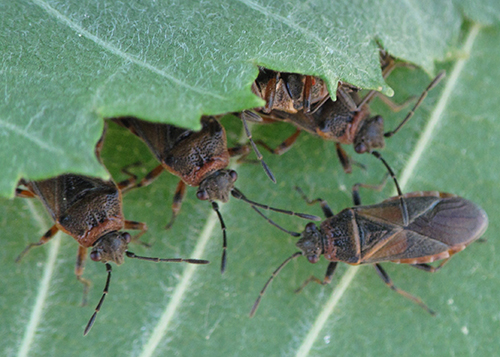Ask an Expert
Question from Rob, Grand Junction, CO -
Would you happen to know of any contacts (university, city foresters, etc.) from areas that have had more experience working with populations of elm seed bug (Arocatus melanocephalus)?
I know this pest has been coined “only a nuisance”, but the calls from residents continue to come in on a daily basis (feels like I’m getting more ESB calls in Junction than I was getting EAB calls in Denver).
I understand Idaho and Utah infestations are a few years ahead of the infestation on the Western Slope of CO, and I always like to see what ideas / insight others may have to offer (especially those who’ve been dealing with issues longer).

Answer from Ryan Davis, Arthropod Diagnostician, Utah Plant Pest Diagnostic Lab -
Hi Rob,
Our experience in Utah has been that when ESB were finally starting to get noticed (2014) they were a huge problem. My phone was ringing off the hook like never before for any pest - just like what you described. The high populations seemed to persist for 2-3 years, but now they have seemed to quiet down. Whitney Cranshaw (CSU) mentioned discussing a similar thing with others in the intermountain west. I suspect this will be a big problem at first and then may dissipate over time. Of course, their populations may be cyclic, but we'll just have to see about that.
Concerning management: synthetic pyrethroids applied as a perimeter barrier treatment to a structure is the primary recommendation (including around windows, doors and even eaves, if necessary). Exclusion and vacuuming bugs in the structure is also important, but they are very small and can enter a structure seemingly through ANY hole. I have been recommending that people use white duct tape around their window screens to close that little gap between the screen frame and the window frame. They can easily get in that way and then squeeze between windows. I have personally used Demand CS, a microcencapsulated formulation of Lambda-Cyhalothrin for ESB management and it has worked very well and lasts for at least a month-and-a-half. I imagine that any microcap or wettable powder pyrethroid labeled for use as a perimeter barrier treatment would work well. Demand CS seems to be the leader in that category, however. Demand CS is the only product I know of with a special label for ESB. In Utah only the application site, not the insect, has to be listed on the insecticide label.
FYI: we are not recommending treating trees or removing trees, unless the elms happen to be very isolated. As populations may equilibrate, it may be worth waiting it out a few years to see what happens. I have often wondered if imidacloprid applied in the late fall would allow chemical to arrive in the seeds and leaves in the spring, where these ESB feed while they are young. They also feed on leaves, so imidacloprid would end up there, too. ESB, of course, is not on imidacloprid labels, but certainly soft scales (i.e., European elm scale) is, if you need a labeled target pest on Siberian elm.
Please send more questions if you have them; I am happy to help out. Additional information on ESB.

